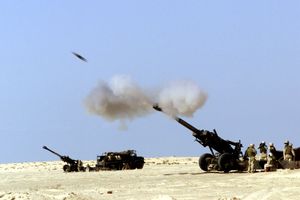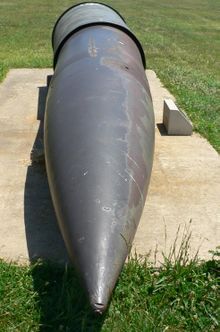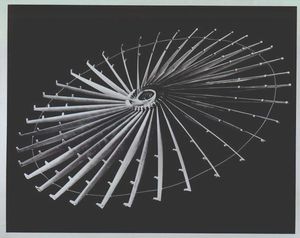قذيفة

القذيفة projectile، هي أي جسم يتم قذفه إلى الفضاء (فارغ أو غير فارغ) بقوة خارجية ثم يتحرك بحرية تحت تأثير الجاذبية ومقاومة الهواء.[1][2] على الرغم من أن أي جسم يتحرك عبر الفضاء (مثل كرة البيسبول يمكن اعتباره مقذوفة، فإن هذا المصطلح يستخدم عادة للاشارة إلى الأسلحة.[3][4]
In ballistics mathematical equations of motion are used to analyze projectile trajectories through launch, flight, and impact.
القوة المحركة

Blowguns and pneumatic rifles use compressed gases, while most other guns and cannons utilize expanding gases liberated by sudden chemical reactions by propellants like smokeless powder. Light-gas guns use a combination of these mechanisms.
Railguns utilize electromagnetic fields to provide a constant acceleration along the entire length of the device, greatly increasing the muzzle velocity.
Some projectiles provide propulsion during flight by means of a rocket engine or jet engine. In military terminology, a rocket is unguided, while a missile is guided. Note the two meanings of "rocket" (weapon and engine): an ICBM is a guided missile with a rocket engine.
An explosion, whether or not by a weapon, causes the debris to act as multiple high velocity projectiles. An explosive weapon or device may also be designed to produce many high velocity projectiles by the break-up of its casing; these are correctly termed fragments.
في الرياضة
In projectile motion the most important force applied to the ‘projectile’ is the propelling force, in this case the propelling forces are the muscles that act upon the ball to make it move, and the stronger the force applied, the more propelling force, which means the projectile (the ball) will travel farther. See pitching, bowling.
كسلاح
مقذوفات التوصيل
Many projectiles, e.g. shells, may carry an explosive charge or another chemical or biological substance. Aside from explosive payload, a projectile can be designed to cause special damage, e.g. fire (see also early thermal weapons), or poisoning (see also arrow poison).
المقذوفات الحركية

سلاح الطاقة الحركية يُعرف أيضاً بإسم السلاح الحركي، kinetic energy warhead, kinetic warhead, kinetic projectile, kinetic kill vehicle) is a weapon based solely on a projectile's kinetic energy instead of an explosive or any other kind of payload.
The term Hit-to-kill, or kinetic kill, is also used in the military aerospace field to describe kinetic energy weapons. It has been used primarily in the anti-ballistic missiles (ABM) and anti-satellite weapons (ASAT) area, but some modern anti-aircraft missiles are also hit-to-kill. Hit-to-kill systems are part of the wider class of kinetic projectiles, a class that has widespread use in the anti-tank field.
Typical kinetic energy weapons are blunt projectiles such as rocks and round shots, pointed ones such as arrows, and somewhat pointed ones such as bullets. Among projectiles that do not contain explosives are those launched from railguns, coilguns, and mass drivers, as well as kinetic energy penetrators. All of these weapons work by attaining a high muzzle velocity, or initial velocity, generally up to hypervelocity, and collide with their targets, converting the kinetic energy associated with the relative velocity between the two objects into destructive shock waves and heat. Other types of kinetic weapons are accelerated over time by a rocket engine, or by gravity. In either case, it is this kinetic energy that destroys its target.مقذوف بسلك
Some projectiles stay connected by a cable to the launch equipment after launching it:
- for guidance: wire-guided missile (range up to 4،000 متر أو 13،000 أقدام)
- to administer an electric shock, as in the case of a Taser (range up to 10.6 متر أو 35 أقدام); two projectiles are shot simultaneously, each with a cable.
- to make a connection with the target, either to tow it towards the launcher, as with a whaling harpoon, or to draw the launcher to the target, as a grappling hook does.
سرعة المقذوفة
| المقذوفة | السرعة | Specific kinetic energy (J/kg) | |||
|---|---|---|---|---|---|
| (م/ث) | (كم/س) | (قدم/ث) | (mph) | ||
| Object falling 1 m (in vacuum, at Earth's surface) | 4.43 | 15.948 | 14.5 | 9.9 | 9.8 |
| Object falling 10 m (in vacuum, at Earth's surface) | 14 | 50.4 | 46 | 31 | 98 |
| Thrown club (expert thrower) | 40 | 144 | 130 | 90 | 800 |
| Object falling 100 m (in vacuum, at Earth's surface) | 45 | 162 | 150 | 100 | 980 |
| Refined (flexible) atlatl dart (expert thrower) | 45 | 162 | 150 | 100 | 1,000 |
| Ice hockey puck (slapshot, professional player) | 50 | 180 | 165 | 110 | 1,300 |
| 80-lb-draw pistol crossbow bolt | 58 | 208.8 | 190 | 130 | 1,700 |
| War arrow shot from a 150 lbs medieval warbow | 63 | 228.2 | 208 | 141 | 2,000 |
| Paintball fired from marker | 91 | 327.6 | 300 | 204 | 4,100 |
| 175-lb-draw crossbow bolt | 97 | 349.2 | 320 | 217 | 4,700 |
| Air gun pellet 6 mm BB | 100 | 360 | 328 | 224 | 5,000 |
| Rifle bullet 4.5 mm | 150 | 540 | 492 | 336 | 11,000 |
| Air gun pellet (magnum-power air rifle) | 305 | 878.4 | 1,000 | 545 | 29,800 |
| 9×19 mm (bullet of a pistol) | 340 | 1224 | 1,116 | 761 | 58,000 |
| 12.7×99 mm (bullet of a heavy machine gun) | 800 | 2,880 | 2,625 | 1,790 | 320,000 |
| German Tiger I 88 mm (tank shell- Pzgr. 39 APCBCHE) | 810 | 2,899 | 2,657 | 1,812 | 328,050 |
| 5.56×45 mm (standard bullet used in many assault rifles) | 920 | 3,312 | 3,018 | 2,058 | 470,000 |
| 25×1400 mm (APFSDS, tank penetrator) | 1,700 | 6,120 | 5,577 | 3,803 | 1,400,000 |
| 2 kg tungsten Slug (from Experimental Railgun) | 3,000 | 10,800 | 9,843 | 6,711 | 4,500,000 |
| ICBM reentry vehicle | Up to 4,000 | Up to 14,000 | Up to 13,000 | Up to 9,000 | Up to 8,000,000 |
| projectile of a light gas gun | Up to 7,000 | Up to 25,000 | Up to 23,000 | Up to 16,000 | Up to 24,000,000 |
| Satellite in low earth orbit | 8,000 | 29,000 | 26,000 | 19,000 | 32,000,000 |
| Exoatmospheric Kill Vehicle | ~10,000 | ~36,000 | ~33,000 | ~22,000 | ~50,000,000 |
| Projectile (e.g., space debris) and target both in low earth orbit | 0–16,000 | ~58,000 | ~53,000 | ~36,000 | ~130,000,000 |
انظر أيضاً
- Atlatl
- Ballistics
- بارود
- Impact depth
- Kinetic bombardment
- Projectile point
- Projectile use by living systems
- Range of a projectile
- Space debris
- Toypedo
- Trajectory of a projectile
المصادر
- ^ Pius, Okeke; Maduka, Anyakoha (2001). Senior Secondary School Physics. Macmillan,Lagos, Nigeria.
- ^ "projectile". merriam-webster.com. Retrieved 13 April 2017.
- ^ "The free Dictionary". Retrieved 2010-05-19.
- ^ "Dictionary.com". Retrieved 2010-05-19.
- ^ Pepin, Matt (2010-08-26). "Aroldis Chapman hits 105 mph". Boston.com. Archived from the original on 31 August 2010. Retrieved 2010-08-30.
